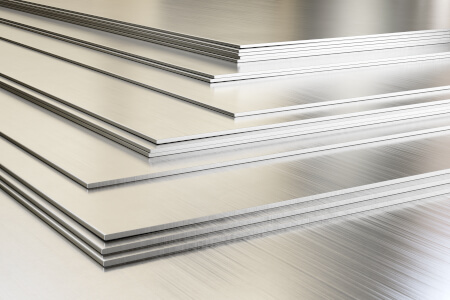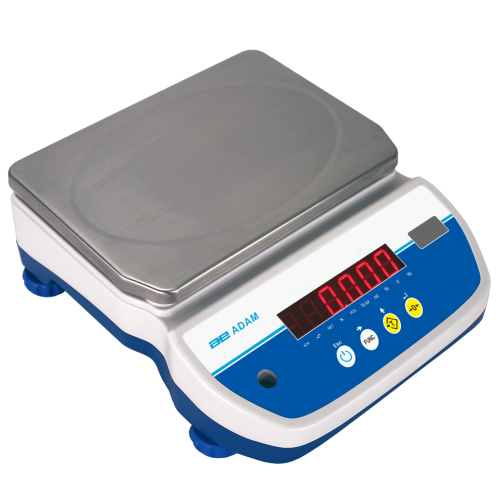
When it comes to scales and balances, stainless steel is a very common material for weighing pans and housings. Why stainless steel? Is stainless steel better than the alternatives? Let’s find out!
Grades of Stainless Steel
First, what exactly is stainless steel? It’s an iron-based alloy that includes at least 10.5 percent chromium in its composition. There are more than 100 grades of stainless steel that are defined by their durability, quality and temperature resistance. The various grades each have slightly different chemical compositions and may have a distinct appearance.
Some of the most commonly used grades of stainless steel are in the 300 and 400 series, including grades 304, 316, 317 and 420. Grades in the 400 series contain more chromium and manganese than grades in the 300 series, making them slightly magnetic, as well as offering a higher carbon content, which gives them greater strength and more resistance to wear, but they corrode more easily.

The 300 series, which is more expensive, is best suited to applications that require greater corrosion resistance (such as from water, chlorides and oxidizing agents), while the 400 series is optimal for applications with greater wear and tear.
What are the differences between some of the most common grades?
- Grade 301 is highly malleable and abrasion resistant, so it’s often used for decorative structures.
- Grade 304 – which represents 50 percent of the steel produced globally – is both attractive and durable. While extremely resistant to corrosion, it’s susceptible to pitting and crevices when used near saline liquids like salt water.
- The second most commonly produced steel, Grade 316’s makeup includes two to three percent molybdenum, which makes it more resistant to saline and a better option for coastal environments. It’s also used for many surgical supplies.
- Grade 317 holds up to corrosion and pitting better than many other grades but is a more expensive option than most grades in the 300 series.
- Very bright in appearance, Grade 420 was one of the earliest carbon/iron alloys. It’s sometimes called “blade grade steel,” because it’s often used to make surgical instruments.
Adam Equipment uses food-safe Grade 304 stainless steel for many of our products, including the NSF-rated Aqua ABW-S stainless steel washdown scales, AE 403 weighing indicators and PT stainless steel platform scales. Containing 18 percent chromium and eight percent nickel, it’s durable, easy to clean and attractive. It’s also easy to source (as we mentioned above, it makes up half of the steel produced worldwide), making it cost-effective both in terms of construction and in offering high value to our customers.

Alternatives to Stainless Steel
In addition to stainless steel, ABS plastic and mild steel are common construction materials for weighing devices. All three are strong and each offers distinct advantages.
Like stainless steel, mild steel is an iron-based alloy. While stainless steel incorporates chromium in its composition, mild steel uses carbon, which results in less resistance to corrosion and less tensile strength. That isn’t to say that mild steel isn’t a strong material: it is strong, but not as strong as stainless steel.
Advantages of mild steel include price (it’s typically less expensive) and how easy it is to weld.
ABS (Acrylonitrile butadiene styrene) plastic is probably a larger presence in our lives that most people realize. Thanks to injection molding, economical ABS easily takes on nearly any shape that’s needed. It’s used in a wide variety of products, including small kitchen appliances, automotive components, musical instruments and even LEGO bricks.
ABS offers a similar resilience and stands up to the same levels of cold and heat as stainless steel. It’s available in fire-retardant and heat-resistant grades, and can be plated. ABS can provide an extensive palette of colors. When compared to stainless steel, its disadvantages are less resistance to solvents, fatigue and UV (unless protected).
Why Stainless Steel?
Of the materials we’ve discussed, stainless steel is certainly the strongest. As a result, less stainless steel can be used in construction to achieve the same level of strength as the other materials. Using less material also results in cost savings, both for manufacturers and consumers.It’s also eco-friendly: it’s 100 percent recyclable and about 60 percent of all new stainless steel comes from recycled material.
Stainless steel products are easy to clean and provide low maintenance. Because of their resistance to corrosion, they’re ideal for washdown scales, which receive an IP rating that indicates their level of protection.
Stainless steel has several strengths in its favor over other materials, but is it better? A better question might be, “is stainless steel better for you?” If you have questions about stainless steel or other materials used in the construction of Adam Equipment products, ask us. We’re here to help!

